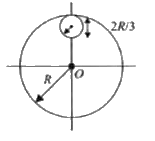From a semicircular disc of radius r1, another semicircular disc of radius r2 is removed. Find the c.m. of the remaining position.

The diagram is symmertical about the y-axis.
m1∝πr212⇒m1=kπr212,y1=4r13π
yc.m.=m1y1−m2y2m2−m2=kπr212×4r13π−kπr222×4r23πkπr212−kπr222
=43π(r31−r32)r21−r22=43π(r1−r2)(r21+r1r2+r22)(r1+r2)(r1−r2)
=4(r21+r1r2+r22)3π(r1+r2)

Topper's Solved these Questions
Similar Questions
From a disc of radius r1, a concentric disc of radius r2 is removed . The mass of the remaining portion is m. Find the M.I. of the remaining about an axis passing through the center of mass and perpendicular to the plane.
View SolutionFrom a circular disc of radius R, another disc of diameter R is removed. Locate c.m. of the remaining portion.

View Solution
Knowledge Check
From a circular disc of radius R and mass 9M, a small disc of radius R/3 is removed from the disc. The moment of inertia of the remaining disc about an axis perpendicular to the plane of the disc and passing through O is
 A4M2B409MR2C10MR2D379MR2
A4M2B409MR2C10MR2D379MR2From a circular disc of radius R and mass 9M, a small disc of radius R/3 is removed as shown in figure. The moment of inertia of the remaining disc about an axis perpendicular to the plane of the disc and passing through O is
 A4MR2B409MR2C40MR2D379MR2
A4MR2B409MR2C40MR2D379MR2Out of a disc of mass M and radius R a concentric disc of mass m and radius r is removed. The M.I. of the remaining part about the symmetric axis will be :
A(M−m)(R+r)2/2B(M−m)(R2−r2)/2C(M−m)(R−r)2/2D(M−m)(R2+r2)/2
From a uniform circular disc of mass M and radius R a small circular disc of radius R/2 is removed in such a way that both have a common tangent. Find the distance of centre of mass of remaining part from the centre of original disc.
View SolutionLocate c.m. of thin , uniform semicircular wire of radius R.
View SolutionFrom a thin uniform disc of radius 2R. Another disc of diameter 2R is removed. The mass of the remaining portion is m. Find the M.I. of the shaded portion about an axis passing through O and pependicular to the plane.
View SolutionFrom a circular disc of mass M and radius R, a part of 60∘ is removed. The M.I. of the remaining portion of disc about an axis passing through the center and perpendicular to plane of disc is

View SolutionFrom a circular disc of radius R and 9M , a small disc of mass M and radius R3 is removed concentrically .The moment of inertia of the remaining disc about and axis perpendicular to the plane of the disc and passing through its centre is
View Solution

